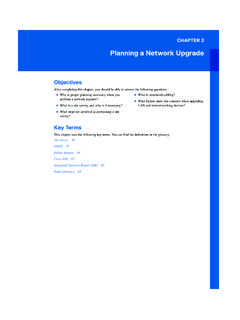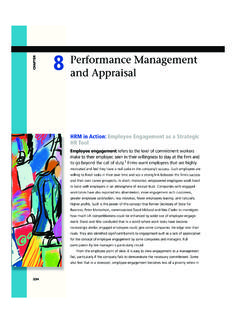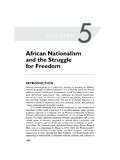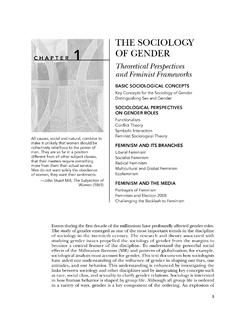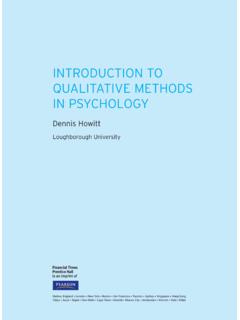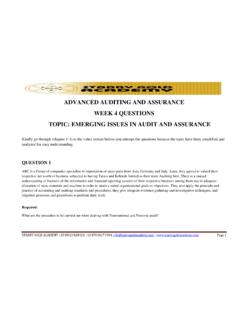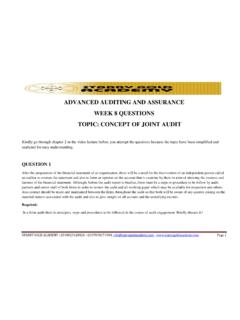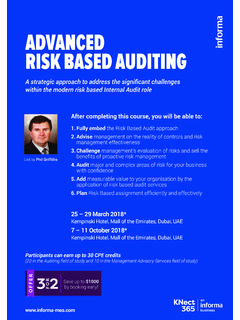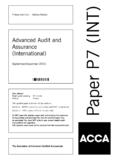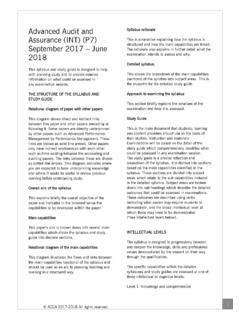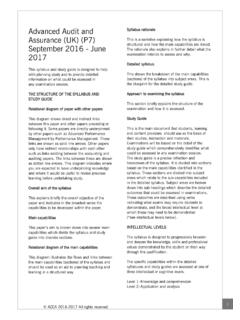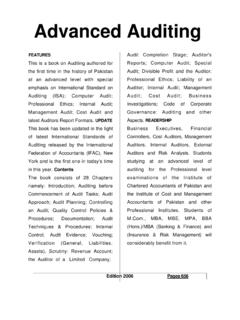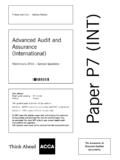Transcription of AN INTRODUCTION TO AUDITING AND ASSURANCE
1 Learning objectivesAfter studying this chapter, you should be able to:1 Discuss the influence of environmental factors on the auditor s role in thecapital market developments in AUDITING and explain the economic intuitionsbehind ASSURANCE an overview of the theoretical reflections and philosophy of the features of AUDITING as a scientific the effect of recent changes proposed by regulatory bodies on theauditor s what ASSURANCE services are, define their different types andunderstand why they are the nature and objectives of attestation services performed bypublic ASSURANCE services and other professional services, includingfinancial-statement audits and non- ASSURANCE services provided byindependent the conditions that distinguish an attest engagement from historical and anticipated future developments related to INTRODUCTION TO AUDITING AND ASSURANCEC hapter 12/8/06 2:37 PM Page 1 CHAPTER 1AN INTRODUCTION TO AUDITING AND ASSURANCE2 IntroductionThis chapter gives prominence to the conceptual development of AUDITING over the pastdecades.
2 It outlines some reflections on AUDITING as a discipline rather than discussing onlythe practices of AUDITING . It also discusses the features of ASSURANCE services. Because of theimportance of theoretical aspects and the need for a new perspective in AUDITING , thisintroductory chapter starts by discussing AUDITING as a field of knowledge and its philo-sophy. Some readers may prefer a discussion of practical notions of AUDITING as the starting point, this book puts the theory and philosophy first because they are, after all,the foundations of audit practices. The objective is not to simply add to the great store of information about audit practices, but to understand and explain themand hopefullypredict the road chapter starts with a number of questions about the critical role of auditors in achanging environment.
3 Here, the idea is to adopt a critical approach to AUDITING and tryto build up an appropriate framework for the fundamental areas of AUDITING that will bediscussed in the following chapters. Even if, because of the introductory nature of thischapter, not all the fundamental issues are included, some essential theoretical aspects ofauditing, its foundations and the demand for ASSURANCE and attestation services aredebated. For the other important topics (expectation gap, auditor independence, ethics,etc.) a reference has been made to the discussions in later opening with questions on the role of the audit, this chapter attempts to provide aroad map for discussion in later chapters.
4 The discussion on other fundamental issues ofauditing in the chapter (theoretical aspects, ASSURANCE , attestation, etc.) tries to provide a carefully balanced presentation of AUDITING theory and practice, similar to that in the following about the critical role of auditorsIt is rather unusual to start a textbook on AUDITING with questions on the role of , understanding AUDITING and its prominent place in the economy are better doneby taking a critical approach to the industry and the audit process. Part of the confusiontoday surrounding the role of AUDITING stems from a misunderstanding of its nature andprecise is subject to continuous changes brought about by technological advances,globalization and internationalization, and the way entities are organized and conducttheir business.
5 Management s increasing discretion over corporate accounts, andunprecedented competitive pressure have also increased the danger of fraudulent finan-cial reporting. The scandals and financial failures of recent years have been a force drivingchange, especially in the attitudes of market regulators. Corporate reporting and theauditing profession are being swept along by this the aftermath of recent scandals, there have been calls for enhanced corporate governance and risk management, as well as increasing quality and scrutiny in has been a raft of laws, regulations, listings requirements and reporting 12/8/06 2.
6 37 PM Page 2 QUESTIONS ABOUT THE CRITICAL ROLE OF AUDITORS3 Standard-setters and market regulatory bodies seem determined to keep financial report-ing and AUDITING standards under close and continuing all the changes in AUDITING are necessary is an important question facing thebusiness community, particularly the accounting profession, and academics interested inthis area. Everyone concerned with financial reporting is now rethinking how they look atauditing, what auditors do and what they should be following are some core questions. Reflection on them will contribute to a betterunderstanding of the role of the auditor and how this should evolve to keep pace with achanging environment.
7 Are auditors crucial economic actors in the capital market economy? Is AUDITING an added-value function? What does the business community expect of external auditors? With several areas of conflict of interest surrounding the auditor s function and his/herperformance, how can independence be assured? How should auditors respond to continuous environmental changes? How should auditors handle complex information systems with linked business processes? Will auditors need to move from an archival approach, where the auditor comes in atthe end of the year, examines financial statements and issues an opinion on the state-ments, to an approach based on the process during which the financial information iscompiled?
8 Will AUDITING need to move from an annual ASSURANCE to a continuous ASSURANCE ? How should the audit profession respond to structural changes in the capital marketeconomy? What short-term measures should be undertaken by auditors? How should auditors respond to changes in the long term? How efficient are the traditional AUDITING techniques today? What changes, if any, should be made to improve the efficacy of AUDITING ?These questions need to be discussed. Most of them will be debated in the context ofdiscussions around the topics such as expectation gap in AUDITING (Chapter 2), AUDITING ,business environment and governance (Chapters 3 and 4), international AUDITING andassurance services (Chapters 5 and 6), auditor independence and ethics (Chapter 7), riskmanagement (Chapter 8), the role of AUDITING in technological environments (Chapter13), continuous AUDITING (Chapters 14 and 19), quality control in AUDITING (Chapter 15), AUDITING and financial market (Chapter 17) and auditors and corporate scandals (Chapter 18).
9 These chapters try to emphasize that auditors and academics interested in AUDITING , canno longer develop ruling standards and practices in an ad hocway to respond to environ-mental changes and satisfy public expectations. For years a debate has rumbled along inauditing over what ought to be . Practitioners generally argued that AUDITING was anapplied discipline and meeting market expectation by expressing the opinions on cor-porate financial statements was sufficient. Consequently, although research in auditinghas been increasing, particularly in the past two decades, little has been done to outline atheory of AUDITING .
10 The research in AUDITING has been directed more towards the analysisor theoretical soundness of investigation practices, and to the application of other fields 12/8/06 2:37 PM Page 3 CHAPTER 1AN INTRODUCTION TO AUDITING AND ASSURANCE4 Definition of an auditAn audit of historical financial statements has been defined as a systematic process of objectively obtaining and evaluating evidence regarding assertions about economicactions and events to ascertain the degree of correspondence between those assertions and established criteria, and communicating the results to interested parties. It is a formof attestation service in which the auditor issues a written report expressing an opinionabout whether the financial statements are in material conformity with generally acceptedaccounting principles or other recognized criteria.

